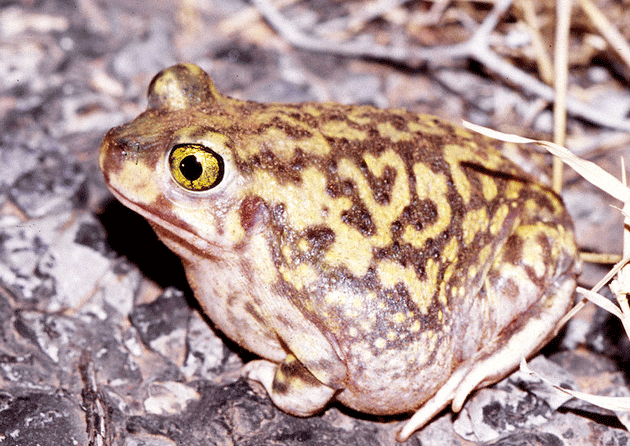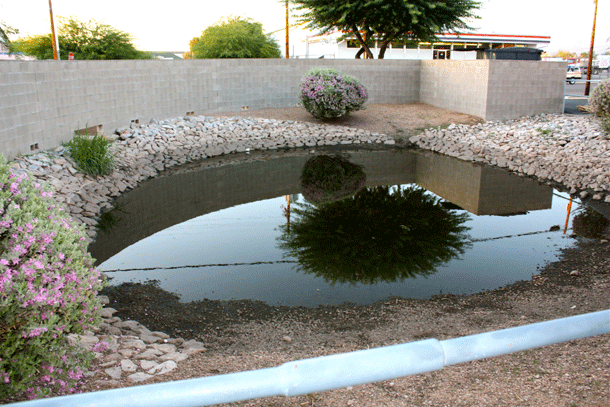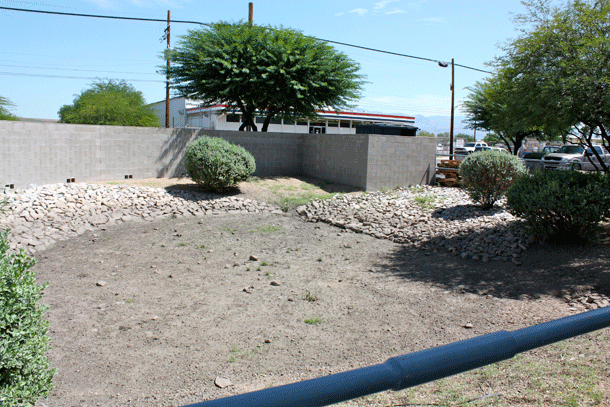Toads in Tuscon
Air Date: Week of September 27, 2013

Couch’s Spadefoot Toad (Photo: Reptilist Flickr Creative Commons)
The US southwest is typically a dry and dusty desert, yet in summer torrential rains can spawn the sudden appearance of noisy amphibians. Sarah Bromer reports from Tucson.
Transcript
CURWOOD: Now the US monsoon, the fierce and sometimes torrential summer rains in the southwest, has dominated the news lately because of devastating floods in Colorado. But in nearby Arizona, there's been a fairly normal amount of rainfall, creating the usual flooded streets and sudden ponds - prime breeding habitat for mosquitoes. And in the cities, local officials try to rid of the standing water, but for some desert animals those brief pools can mean the difference between life and death. From Tucson, Sarah Bromer has the story.
BROMER: I was out taking a walk one night after a summer storm in downtown Tucson when I heard a sound I’d never heard before:
[SOUND OF TOADS]
BROMER: It kind of sounded like a flock of sheep.
[SOUND OF TOADS]
BROMER: But that seemed unlikely, given that I only live a few blocks from the center of downtown.
[MORE CROAKING]
BROMER: So I followed the sound, to the edge of my neighborhood, where I found people gathered with flashlights.
[EXCLAMATIONS OF SURPRISE,]
BROMER: There, in a temporary drainage pond next to a shipping warehouse, were dozens of toads.
[TOAD SOUNDS]
BROMER: Now amphibians are pretty much the last animals you expect to find in a dry, dusty, desert town like Tucson, and nobody seemed to know much about them. So I called an expert.
ROSEN: So I’m Phil Rosen, and I’m a research scientist in Natural Resources and the Environment at the University of Arizona.
BROMER: I took Phil to the pond the next night, and we listened.
[SILENCE AND DISTANT TRAFFIC]
BROMER: But all we heard was…silence. The pond looked a lot smaller. We found tadpoles in the water, but no toads, so I tried to explain the sound to him.
BROMER: Yeah, it sounded like wwwaaaahhhh! [IMITATES SOUND]
ROSEN: wwwwaaaaahhh? [IMITATES SOUND] wwwwaaaaahhh?
BROMER: Yeah, like that.
BROMER: Phil was pretty sure that I’d heard Couch’s spadefoot toads.
ROSEN: I fully expected it to be nothing but Couch’s spadefoot, because of their ability to use such short-lived water. They’re uniquely explosive breeders with very short tadpole stages.
BROMER: He told me the toads spend most of their lives underground, emerging each summer for maybe only a few nights of frantic feeding and breeding. Their eggs hatch within hours, and only seven or eight days later the tadpoles become toads.

Couch’s Spadefoot Toad. (Photo: Tom Spinker)
ROSEN: It’s fastest metamorphosing species here, probably one of the fastest in the world.
BROMER: I thought Phil would be really excited to find prime toad breeding habitat in the middle of the city, but he wasn’t very excited at all. He told me that the water in the pond probably wouldn’t last long enough for the tadpoles to turn into toads.
ROSEN: This basin that we’re standing next to is designed to uh dry itself within three days. It’s too bad because it is like an ecological trap because it just seems really good for them but it’s… huh... It’s an attractive nuisance for them, basically. It brings them into breed in a place they can’t survive.
BROMER: Tucson’s building codes require all businesses to capture their run-off, so it won’t contribute to flooding, and then sink the water into the ground quickly, so it won’t breed mosquitoes. Here’s Phil Rosen again.
ROSEN: Well, you know, this sort of thing worries me, because it exemplifies the ability and the tendency of people to just keep modifying the environment, and making it more and more perfect for people, and, unfortunately, there’s less tendency for there to be little corners where water lasts for two or three or four weeks…and so I suspect there’s an ongoing, very steady decline of these species throughout most the city.
BROMER: Now you wouldn’t think mosquitoes would be a big problem in the Southwest. Tucson gets less than 12 inches of rain a year. But over half of it falls during what people around here call the monsoon season, in July, August, and September. It floods the streets and forms temporary pools all over the city. And when the water comes, so do the mosquitoes.

A monsoon storm heating up in Pima County, AZ. (Photo: Katja Schulz)
ACOBA: Mosquitoes really just need water and a warm blood source in order to thrive, so we do have that in Tucson, especially during the times of our monsoon, when we have a lot of rain.
BROMER: That’s Dr. Michael Acoba. He’s the head of epidemiology at the County Health Department
ACOBA: Well, the majority of the time, the mosquitoes we have, they’re just a nuisance, but since 2004, we had our first case of West Nile Virus here. The number of cases spiked one year to about 40 cases, but usually we see about 10-20 cases a year.
BROMER: So what if we want toads in our neighborhood, but not mosquitoes? According to Phil Rosen, it’s possible to have one without the other.
ROSEN: If a pond, let’s say, like this one lasted say on average 2 to 3 months, it would be so full of predatory crustaceans and insects, that it wouldn’t really produce any mosquitoes.
BROMER: To prove his point he took me to a nearby drainage basin, in a neighborhood squeezed between the freeway and the dry Santa Cruz riverbed. The basin was dammed up at one end with sediment and old tires, and its concrete sides were covered with graffiti.

At least 5 species of toads use this concrete drainage ditch for reproduction. (Photo: Sarah Bromer)
[TRILLING TOADS FADE IN]
BROMER: It was not a pretty sight. But it was full of toads.
ROSEN: So this is a highly engineered, concrete drainage outlet, and the mouth of it is blocked by flood debris, and so it’s formed a pretty deep pool, and right now there are two species of true toads breeding it. Those loud ones are Great Plains Toads and the more musical trill are Red-spotted toads.
[MORE TRILLING TOADS]
BROMER: We climbed down to the water and Phil pointed out all the tiny animals that eat mosquito larvae.
ROSEN: I’m interested in the invertebrates here. There’s all kinds of little beetles swimming around here whose larvae will eat mosquitoes. There’s a tadpole shrimp. There’s quite a few of them. Trying to see if there’s any mosquito larvae…because everyone would sort of expect there to be tons of mosquito larvae in a place like this, making it a public health nuisance. But with this number of aquatic invertebrates, mosquitoes might have a very hard time surviving here…and I’m not seeing any.
BROMER: The County Health Department here deals with mosquitoes by either eliminating standing water or treating it a larvicide. Jeff Terrell manages the vector control program for the department.
TERRELL: Well larvicide we use it’s usually like a—what they call a—BTI, which is a bacteria. Um we do use a larvicide oil which is more of a mineral oil with a surfactant that spreads over the water and keeps it, you know, keeps the larvae from breaking the water surface and breathing so they drown.
BROMER: Both BTI and mineral oil, if used correctly, are generally considered safe for toads and other vertebrates. But at least one study showed that BTI might sometimes target insects it’s not supposed to, and the oil kills several of the aquatic invertebrates that serve as natural pest control.

A drainage pond after summer rains attracts toads. (Sarah Bromer)
Phil Rosen suspects that the oil isn’t good for tadpoles, either. He’s been researching alternative solutions, and local officials have been open to his ideas. He’s been working with them to design experimental pools of longer-standing water that use invertebrate biodiversity to control mosquitoes.
ROSEN: So, I’ve been working to develop that it into kind of an art form…because I completely sympathize with people not wanting to live around lots of mosquitoes.
BROMER: He believes that in the long run his solution, though more complicated, will be the best one.
ROSEN: You know, if we simplify our environment, we’re going to end up with just the things we can’t deal with, diseases, and vectors, and things like that. We’ll either have to reengineer everything so there’s zero standing water, or we’ll have to try to live with the biodiversity and turn it to our ends and …let the kids growing up have something interesting to grow up with…

The same drainage pond three days later has dried up completely. (Photo: Sarah Bromer)
BOMER: I went back to the pond in my neighborhood a few days later, and, as Phil had predicted, all of the water was gone. Birds were pecking at the muck. I guess it wasn’t a good year for the Couch’s spadefoots of downtown Tucson. But maybe someday this pond will be reengineered …
[SOUNDS OF SPADEFOOT TOADS]
BROMER: …and stocked with the right kinds of invertebrates, which will allow us to have the best of both worlds: a neighborhood that’s rich with biodiversity and singing toads, and not too many mosquitoes. For Living On Earth, I’m Sarah Bromer in Tucson.
Living on Earth wants to hear from you!
Living on Earth
62 Calef Highway, Suite 212
Lee, NH 03861
Telephone: 617-287-4121
E-mail: comments@loe.org
Newsletter [Click here]
Donate to Living on Earth!
Living on Earth is an independent media program and relies entirely on contributions from listeners and institutions supporting public service. Please donate now to preserve an independent environmental voice.
NewsletterLiving on Earth offers a weekly delivery of the show's rundown to your mailbox. Sign up for our newsletter today!
 Sailors For The Sea: Be the change you want to sea.
Sailors For The Sea: Be the change you want to sea.
 The Grantham Foundation for the Protection of the Environment: Committed to protecting and improving the health of the global environment.
The Grantham Foundation for the Protection of the Environment: Committed to protecting and improving the health of the global environment.
 Contribute to Living on Earth and receive, as our gift to you, an archival print of one of Mark Seth Lender's extraordinary wildlife photographs. Follow the link to see Mark's current collection of photographs.
Contribute to Living on Earth and receive, as our gift to you, an archival print of one of Mark Seth Lender's extraordinary wildlife photographs. Follow the link to see Mark's current collection of photographs.
 Buy a signed copy of Mark Seth Lender's book Smeagull the Seagull & support Living on Earth
Buy a signed copy of Mark Seth Lender's book Smeagull the Seagull & support Living on Earth

